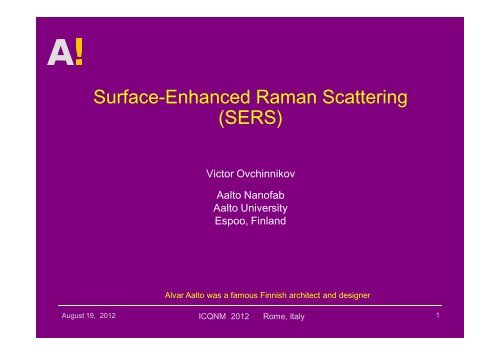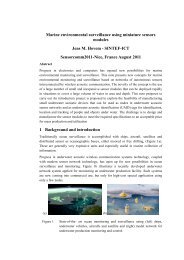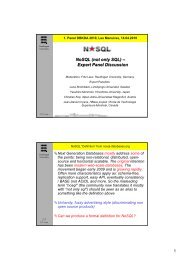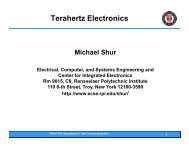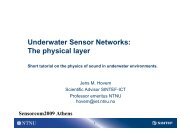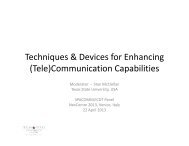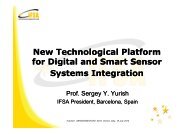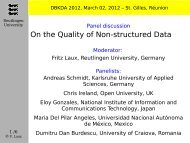Surface-Enhanced Raman Scattering (SERS) - iaria
Surface-Enhanced Raman Scattering (SERS) - iaria
Surface-Enhanced Raman Scattering (SERS) - iaria
You also want an ePaper? Increase the reach of your titles
YUMPU automatically turns print PDFs into web optimized ePapers that Google loves.
<strong>Surface</strong>-<strong>Enhanced</strong> <strong>Raman</strong> <strong>Scattering</strong><br />
(<strong>SERS</strong>)<br />
Victor Ovchinnikov<br />
Aalto Nanofab<br />
Aalto University<br />
Espoo, Finland<br />
Alvar Aalto was a famous Finnish architect and designer<br />
August 19, 2012 ICQNM 2012 Rome, Italy 1
Outline<br />
• Bulk <strong>Raman</strong> spectroscopy<br />
• <strong>SERS</strong> principles<br />
• Plasmonics<br />
• <strong>SERS</strong> substrate – nanoengineering<br />
• Instrumentation<br />
• Applications<br />
August 19, 2012 ICQNM 2012 Rome, Italy 2
Pros and cons of <strong>Raman</strong> (<strong>SERS</strong>)<br />
• Advantages<br />
– Can be used with solids, liquids or gases<br />
– No sample preparation needed (KBr, nujol)<br />
– Non-destructive, non-invasive<br />
– Works in-situ and in-vitro for biological samples<br />
– No vacuum needed<br />
– Works under a wide range of conditions (temperature, pressure)<br />
– Short time scale<br />
– Can work with aqueous solutions<br />
– Glass vials can be used<br />
– Can use down fibre optic cables for remote sampling<br />
– Very small analizing volume – till single molecule (<strong>SERS</strong>)<br />
– Extremely high spatial resolution (<strong>SERS</strong>)<br />
• Disadvantages<br />
– Cannot be used for metals or alloys<br />
– Very low sensitivity (<strong>Raman</strong>)<br />
– Can be swamped by fluorescence from some materials<br />
August 19, 2012 ICQNM 2012 Rome, Italy 3
Scattered radiation<br />
Incident light (I 0 , 0 )<br />
a
Energy levels<br />
=2<br />
Excited<br />
electron<br />
states<br />
=1<br />
=0<br />
Virtual<br />
states<br />
E 2<br />
=2<br />
Vibrational<br />
states<br />
h<br />
E 1<br />
E 0<br />
IR Rayleight<br />
Stokes Anti-Stokes<br />
<strong>Raman</strong> <strong>Raman</strong><br />
0 <br />
0 <br />
Fluorescence<br />
=1<br />
=0<br />
isindependentof 0<br />
August 19, 2012 ICQNM 2012 Rome, Italy 5
Molecular vibrations<br />
Electronic<br />
levels<br />
E.C. Le Ru and P. G. Etchegoin, Principles of <strong>Surface</strong>-<strong>Enhanced</strong> <strong>Raman</strong> Spectroscopy and related plasmonic eects, Elsevier , 2009<br />
http://chemwiki.ucdavis.edu<br />
August 19, 2012 ICQNM 2012 Rome, Italy 6
Dipole moment in a molecule<br />
0 - molecule equilibrium polarizability<br />
E 0 - maximum electric field<br />
0 - excitation and vibrational frequency, respectively<br />
r max - maximum vibrational amplitude<br />
’Modulation’ of linear optical polarizabiliy due to presence of internal vibrations<br />
Spectroscopy 16(11), 2001, p.32<br />
August 19, 2012 ICQNM 2012 Rome, Italy 7
Selection rules<br />
• The polarizability must change during the vibration<br />
• In a centrosymmetric molecule (i.e., one with a centre of<br />
inversion symmetry) a vibrational mode may be either IR active<br />
or <strong>Raman</strong> active, but not both.<br />
mackenzie.chem.ox.ac.uk/teaching/<strong>Raman</strong>%20<strong>Scattering</strong>.pdf<br />
August 19, 2012 ICQNM 2012 Rome, Italy 8
IR vs <strong>Raman</strong><br />
Polystyrene<br />
Senses dipole vibrations, i.e. functional<br />
groups. O-H, N-H, C=O<br />
Senses polarizable vibrations, i.e.<br />
carbon backbones. C=C, aromatics<br />
http://www.brukeroptics.com/senterra-overview.html<br />
August 19, 2012 ICQNM 2012 Rome, Italy 9
<strong>Raman</strong> intensity<br />
N – volume density of scattering molecule<br />
<strong>Raman</strong> shift (wave-number)<br />
Anti-Stokes to Stokes ratio for k mode<br />
- wavelength<br />
Krafft et al., Journal of Biomedical Optics, 17, 2012, p.040801-15<br />
E.C. Le Ru and P. G. Etchegoin, Principles of <strong>Surface</strong>-<strong>Enhanced</strong> <strong>Raman</strong> Spectroscopy and related plasmonic eects, Elsevier , 2009.<br />
August 19, 2012 ICQNM 2012 Rome, Italy 10
Stokes vs anti-Stokes<br />
Rayleigh<br />
line<br />
anti-Stokes<br />
Stokes<br />
E.C. Le Ru and P. G. Etchegoin, Principles of <strong>Surface</strong>-<strong>Enhanced</strong> <strong>Raman</strong> Spectroscopy and related plasmonic eects, Elsevier , 2009<br />
August 19, 2012 ICQNM 2012 Rome, Italy 11
Spectrum examples<br />
Polysterene beads<br />
Laser 785 nm<br />
Glass<br />
Laser 514 nm<br />
Laser 514 nm<br />
Bankapur A et all, (2010) .PLoS ONE 5(4): e10427.<br />
doi:10.1371/journal.pone.0010427.<br />
Laboratoire de Sciences de la Terre ENS-Lyon<br />
www.perkinelmer.com , Introduction to <strong>Raman</strong> Spectroscopy<br />
J. <strong>Raman</strong> Spectrosc. 2004; 35: 82–86<br />
August 19, 2012 ICQNM 2012 Rome, Italy 12
Cross-sections of the optical processes<br />
R. Aroca, <strong>Surface</strong>-Enhancend Vibrational Spectroscopy, J.Wiley & Sons Ltd, 2007<br />
August 19, 2012 ICQNM 2012 Rome, Italy 13
Intermediate conclusion I<br />
• <strong>Raman</strong> spectroscopy provides ‘fingerprint’ of<br />
molecular bonds and crystalline structure<br />
(phonons) in dependence on environment<br />
conditions (temperature, pressure …) through<br />
non-resonance excitation of any vibrational<br />
transitions<br />
• At the same time method applications in real life<br />
are hindered by very low cross-section of<br />
<strong>Raman</strong> scattering<br />
August 19, 2012 ICQNM 2012 Rome, Italy 14
Steps of <strong>Raman</strong> development<br />
• Laser application<br />
– dramatically improved power of excitation and <strong>Raman</strong><br />
signal<br />
• <strong>SERS</strong> effect<br />
– <strong>Enhanced</strong> method sensitivity up to 10 14<br />
• <strong>Raman</strong> microscope<br />
– Decreased probe volume (light spot diameter below 1 m<br />
• Portable <strong>SERS</strong><br />
– Mobility of analyses<br />
C. Douketis et al., J. Chem. Phys. 2000, 113, 11315-23<br />
August 19, 2012 ICQNM 2012 Rome, Italy 15
<strong>SERS</strong> discovery<br />
• M. Fleischmann, P. J. Hendra, and A. J. McQuillan.<br />
“<strong>Raman</strong> spectra of pyridine adsorbed at a silver<br />
electrode.”Chem. Phys. Lett., 26, 1974, p.163–66<br />
• Jeanmaire D.L. and Van Duyne R.P., “<strong>Surface</strong> <strong>Raman</strong><br />
spectroelectrochemistry, part 1: heterocyclic, aromatic,<br />
and aliphatic amines adsorbed on the anodized silver<br />
electrode.” J. Electroanal. Chem., 84, 1977, p.120<br />
• Albrecht and Creighton, ”Anomalously intense <strong>Raman</strong><br />
spectra of pyridine at a silver electrode.” J. Am. Chem.<br />
Soc., 99, 1977, p.5215-17<br />
August 19, 2012 ICQNM 2012 Rome, Italy 16
<strong>SERS</strong> experiment with pyridine<br />
adsorbed on silver<br />
KCl in water<br />
McQuillan A J Notes Rec. R. Soc. 2009;63:105-109<br />
©2009 by The Royal Society
<strong>SERS</strong> definitions<br />
• <strong>SERS</strong> is a phenomenon associated with the<br />
enhancement of the electromagnetic field surrounding<br />
small objects optically excited near an intense and sharp<br />
plasmon resonance. The enhanced fields excite the<br />
adsorbate (probe) and the scattered radiation will again<br />
be enhanced.<br />
• <strong>Surface</strong>-enhanced <strong>Raman</strong> scattering (<strong>SERS</strong>) consists in<br />
using the large local field enhancements that can exist at<br />
metallic surfaces (under the right conditions, typically by<br />
profiting from localized surface plasmon resonances) to<br />
boost the <strong>Raman</strong> scattering signal of molecules at (or<br />
close to) the surface.<br />
E.C. Le Ru and P. G. Etchegoin, Principles of <strong>Surface</strong>-<strong>Enhanced</strong> <strong>Raman</strong> Spectroscopy and related plasmonic eects, Elsevier , 2009<br />
August 19, 2012 ICQNM 2012 Rome, Italy 18
First experience<br />
• <strong>SERS</strong> conditions:<br />
– specic metals (e.g. Au, Ag, Cu, Pt, ...)<br />
– surfaces with roughness on the nanometer scale<br />
– proper wavelength of excitation<br />
• <strong>SERS</strong> results:<br />
– no enhancements observed for water, methanol, etc -<br />
most solvents...<br />
– certain molecules provided much higher <strong>Raman</strong><br />
intensities (mostly molecules with carbon doublebonds)<br />
August 19, 2012 ICQNM 2012 Rome, Italy 19
Bulk <strong>Raman</strong> versus <strong>SERS</strong><br />
<strong>Surface</strong> selectrion rules<br />
633 nm, 3 mW,<br />
rhodamine RH6G<br />
Bottom spectrum: 100 µM solution in a 13 µm 3 scattering volume, × 100 immersion objective with 400 s<br />
integration time. Top: signal from a single molecule under the same experimental conditions, but with 0.05 s integration time.<br />
E. C. Le Ru et al., J. Phys. Chem. C, 111, 2007, p.13794–803<br />
August 19, 2012 ICQNM 2012 Rome, Italy 20
Deilectric function of metals<br />
E.C. Le Ru and P. G. Etchegoin, Principles of <strong>Surface</strong>-<strong>Enhanced</strong> <strong>Raman</strong> Spectroscopy and related plasmonic eects, Elsevier , 2009.<br />
August 19, 2012 ICQNM 2012 Rome, Italy 21
Lolcalized surface plazmon resonance<br />
(SPR) in metal sphere<br />
The (complex) electric field inside the sphere is constant<br />
Ag sphere (35nm) in vacuum,<br />
at resonance wavelength 370 nm<br />
Max 85<br />
M -relative dielectric constant of medium<br />
Plasmon<br />
E.C. Le Ru and P. G. Etchegoin, Principles of <strong>Surface</strong>-<strong>Enhanced</strong> <strong>Raman</strong> Spectroscopy and related plasmonic eects, Elsevier , 2009.<br />
Stiles P.L. et all, Annual Review of Analytical Chemistry, 1, 2008, p.601-26<br />
August 19, 2012 ICQNM 2012 Rome, Italy 22
Optical properties of metals<br />
Re() is negative, -20...-1<br />
Im() is small, Q>2<br />
E. D. Palik, editor. Handbook of optical constants of solids III. Academic Press, New York, 1998.<br />
E.C. Le Ru and P. G. Etchegoin, Principles of <strong>Surface</strong>-<strong>Enhanced</strong> <strong>Raman</strong> Spectroscopy and related plasmonic eects, Elsevier , 2009<br />
August 19, 2012 ICQNM 2012 Rome, Italy 23
Material and size effect in plasmon<br />
resonance<br />
AuAg alloy nanoparticles with increasing Au concentration<br />
Au nanorods of increasing aspect ratio<br />
Materials Today, Feb 2004, p. 26-31<br />
August 19, 2012 ICQNM 2012 Rome, Italy 24
Plasmonic welding<br />
Before<br />
illumination<br />
Gaps due to the presence<br />
of surface ligands<br />
W halogen lamp welding<br />
200 nm 500 nm<br />
Suspended Si 3 N 4 membrane<br />
15–60s at 200–300°C<br />
500 nm<br />
500 nm<br />
E. C. Garnett, Nature Materials 11, 241–249 (2012)<br />
August 19, 2012 ICQNM 2012 Rome, Italy 25
Electromagnetic enhancement in near-field<br />
Molecule<br />
Adenine on Ag nanoclusters<br />
Metal<br />
nanoparticle<br />
I L – laser intensity<br />
<strong>Raman</strong> cross-section<br />
Laser excitation enhancement<br />
Scattered field enhancement<br />
K. Kneipp, Physic Tody, 60(11), 2007, p. 40-46<br />
August 19, 2012 ICQNM 2012 Rome, Italy 26
Electric field outside of metal sphere<br />
B<br />
r<br />
a<br />
<br />
Ag nanosphere on glass<br />
K. Kneipp, Physic Tody, 60(11), 2007, p. 40-46<br />
Stiles P.L. et all, Annual Review of Analytical Chemistry, 1, 2008, p.601-26<br />
August 19, 2012 ICQNM 2012 Rome, Italy 27
E 4 enchancement of outside field<br />
Electric field at the surface of nanosphere<br />
Maximum E out<br />
at =0°<br />
Enhancement factor<br />
Stiles P.L. et all, Annual Review of Analytical Chemistry, 1, 2008, p.601-26<br />
August 19, 2012 ICQNM 2012 Rome, Italy 28
Distance dependence<br />
Pyridine, Ag over nanosphere, Al 2 O 3 , 532 nm<br />
Stiles P.L. et all, Annual Review of Analytical Chemistry, 1, 2008, p.601-26<br />
August 19, 2012 ICQNM 2012 Rome, Italy 29
Ag dimer enhancement<br />
36 nm spheres separated by 2 nm gap<br />
For sphere is 85, slide 22<br />
E. Hao and G. C. Schatz, J. Chem. Phys., Vol. 120, No. 1, 1 January 2004<br />
August 19, 2012 ICQNM 2012 Rome, Italy 30
Wavelength dependence<br />
benzenethiol,<br />
620 nm<br />
NSL with 450nm spheres, 55 nm Ag on glass<br />
SERES – suraface enhanced ecxitation spectroscopy<br />
<strong>SERS</strong> is maximum when laser excitation is between SPR<br />
and the analized specturm line<br />
J. Phys. Chem. B 2005, 109, 11279-11285<br />
August 19, 2012 ICQNM 2012 Rome, Italy 31
SERRS<br />
RRS provides additional<br />
EF = 10 2 -10 6<br />
metallo-porphyrine ring<br />
Resonance<br />
highly conjugated part<br />
Resonance<br />
No resonance<br />
©2011 www.raman.de • Dr. Bernd Dippel<br />
Due to matching of excitation to absorption of a specific part of the molecule, the<br />
<strong>Raman</strong> spectrum associated with this part of the molecule is selectively enhanced<br />
August 19, 2012 ICQNM 2012 Rome, Italy 32
SERRS<br />
• The energy of the incoming laser is adjusted such<br />
that it or the scattered light coincide with an<br />
electronic transition of the molecule or crystal<br />
• The main advantage of RR spectroscopy over<br />
traditional <strong>Raman</strong> spectroscopy is the large increase<br />
in intensity of the peaks in question<br />
• The main disadvantage of RR spectroscopy is the<br />
increased risk of fluorescence and photodegradation<br />
of the sample due to the increased<br />
energy of the incoming laser light<br />
August 19, 2012 ICQNM 2012 Rome, Italy 33
Delivering molecules to metal structures<br />
Droplet formation depends on nature of solution, surface material and surface nanopattern (pillars...)<br />
Molecule attachment may be strong or weak depending on molecule affinity to metal and surface chemistry<br />
www.d3technologies.co.uk - www.renishawdiagnostics.com/en/klarite-sers-substrates<br />
August 19, 2012 ICQNM 2012 Rome, Italy 34
Chemical enhancement<br />
EF EM , EF CE – electromagnetic and chemiclal<br />
enhancement factors, respectively<br />
• Charge transfer (CT) through<br />
metal-molecule complex<br />
• Up to 10 2 contribution<br />
theoretically, up 100 practically<br />
• CT is a special case of resonant<br />
<strong>Raman</strong> scattering<br />
IP – ionization potential,<br />
– work function of the metal<br />
August 19, 2012 ICQNM 2012 Rome, Italy 35
Chemical enhancement<br />
roughened<br />
electrode<br />
Cu colloid<br />
647 nm<br />
roughened<br />
electrode<br />
August 19, 2012 ICQNM 2012 Rome, Italy 36
<strong>SERS</strong> enhancement factor<br />
Analytical enhancement factor<br />
I <strong>SERS</strong> , I RS – intersities of <strong>SERS</strong> and <strong>Raman</strong> signals, respectively<br />
c <strong>SERS</strong> , c RS – molecule concentrations for <strong>SERS</strong> and <strong>Raman</strong>, respectively<br />
<strong>SERS</strong> substrate enhancement factor<br />
N vol = c RS V – number of molecules in the scattering volume V<br />
August 19, 2012 ICQNM 2012 Rome, Italy 37
<strong>SERS</strong> aspects<br />
• Maximum <strong>SERS</strong> EF occurs at specific positions on<br />
the surface (’hot spots’): nanoshpere 10 6 , nanogap<br />
10 11 (SERRS)<br />
• Average <strong>SERS</strong> EF (averaged over all possible<br />
positions on the metallic surface) 10-10 3 for nonoptimized<br />
conditions, 10 7 -10 8 for very good <strong>SERS</strong><br />
substrates.<br />
• Adsorption efficiency of the probe<br />
• Sample transfer on 2D <strong>SERS</strong> substrate<br />
August 19, 2012 ICQNM 2012 Rome, Italy 38
Inetrmediate conclusion II<br />
• High local electromagnetic field near the<br />
plasmon nanostructures provides very high<br />
enhancement of <strong>Raman</strong> scattering (<strong>SERS</strong>)<br />
• <strong>SERS</strong> effect depends on metal-molecule affinity<br />
and resonance conditions in molecule<br />
• The highest EF is reached in random ’hot spots’,<br />
if the probe molecule has got at this ’spot’<br />
August 19, 2012 ICQNM 2012 Rome, Italy 39
<strong>SERS</strong> substrates<br />
• <strong>SERS</strong> substrate is any metallic structure (nanostructure)<br />
that produces the <strong>SERS</strong><br />
enhancement:<br />
– Metallic nano-particles in solution ( colloids)<br />
– ‘Planar’ metallic structures or arrays of metallic nanoparticles<br />
supported on a planar substrate (glass,<br />
silicon)<br />
– Metal electrodes in electrochemistry (roughed<br />
electrodes)<br />
August 19, 2012 ICQNM 2012 Rome, Italy 40
Metal colloids for <strong>SERS</strong><br />
• Mainly Au, Ag or Cu nanoparticles (diameter10 – 80 nm) in water<br />
• Produced by:<br />
– Chemical reduction. Process depends on:<br />
• Kind of metal<br />
• Reducing reagent AgNO3, K(AuCl4)<br />
• Temperature (boiling 1 h)<br />
• Stabilizing agents<br />
• Metal ion concentration<br />
– Laser ablation<br />
– Photoreduction<br />
• The best <strong>SERS</strong> is provided by highly aggregated colloids<br />
• Cube, triangle, nanorod shapes of particle<br />
• The background <strong>SERS</strong> – water 3100 – 3600 cm -1 , ’cathedral peaks’ around 1360 and 1560 cm-1<br />
(amorphous carbon), low-frequincy signals (150 – 250 cm-1) metal complexes Ag-O, Ag-Cl<br />
• Enhancement up to 10 14 (SMD posible)<br />
August 19, 2012 ICQNM 2012 Rome, Italy 41
Colloids images<br />
TEM of Ag citrate colloid<br />
max = 406 nm<br />
TEM of Au borohydride colloid,<br />
Au particles 20-70 nm,<br />
max = 535 nm<br />
TEM of Au nanorods,<br />
max = 525 nm and 885 nm<br />
TEM of Au nanosquares<br />
AFM of Au nanospheres embedded<br />
in film of biopoymer chitosan<br />
(inert organic matrix)<br />
AFM of Ag nanowires<br />
in dendrimer matrix<br />
R.F. Aroca et al. / Advances in Colloid and Interface Science 116 (2005) 45–61<br />
August 19, 2012 ICQNM 2012 Rome, Italy 42
SPR of colloids<br />
Observed effects are due to<br />
particle size, concentration,<br />
aspect ratio.<br />
Absorption<br />
Partical surface charge determs<br />
stability, adsorbivity,<br />
electrokinetic properties<br />
R.F. Aroca et al. / Advances in Colloid and Interface Science 116 (2005) 45–61<br />
August 19, 2012 ICQNM 2012 Rome, Italy 43
Laser induced photo-reaciton<br />
4-nitrobenzenethiol static<br />
4-aminobenzenethiol flow<br />
Ag colloid, 514 nm<br />
4-nitrobenzenethiol flow<br />
R.F. Aroca et al. / Advances in Colloid and Interface Science 116 (2005) 45–61<br />
August 19, 2012 ICQNM 2012 Rome, Italy 44
Gold Lace Nanoshells<br />
PU means amphiphilic polyurethane template<br />
1-naphthalenethiol<br />
50 nm<br />
M. Yang et al., <strong>SERS</strong>-Active Gold Lace Nanoshells with Built-in Hotspots, Nano Lett. 2010, 10, 4013-–4019<br />
August 19, 2012 ICQNM 2012 Rome, Italy 45
Images of single lace nanopartilce<br />
Optical<br />
<strong>Raman</strong><br />
SEM<br />
M. Yang et al., <strong>SERS</strong>-Active Gold Lace Nanoshells with Built-in Hotspots, Nano Lett. 2010, 10, 4013-–4019<br />
August 19, 2012 ICQNM 2012 Rome, Italy 46
Nanoshells<br />
4-mercaptobenzoic acid (MBA)<br />
dvariations<br />
d = (r a -r i )<br />
633 nm<br />
• additional degree of tunability of SPR by<br />
changing the thickness d of shells<br />
• more uniform signal (less fluctuations)<br />
M. Gellner et al. / Vibrational Spectroscopy 50 (2009) 43–47<br />
August 19, 2012 ICQNM 2012 Rome, Italy 47
Metal electrodes<br />
• <strong>Surface</strong> protrusions 25-500 nm<br />
• Ag in KCl electrolyte<br />
• Oxidation-reduction cycles<br />
Methylviolegen<br />
Laser 1064 nm<br />
<strong>SERS</strong><br />
bulk <strong>Raman</strong><br />
Zheng et al., J. Phys. Chem. B, Vol. 106, No. 5, 2002, p.1019-23<br />
August 19, 2012 ICQNM 2012 Rome, Italy 48
’Planar’ substrates - metal island films<br />
• Prepared by PVD – physical vapor deposition<br />
• Applicability to any substrate<br />
• High purity<br />
• Structure can be controlled by deposition rate<br />
(0.5 A/s), substrate roughness, temperature,<br />
mass thickness (6 nm), annealing<br />
• Cold-deposited (-100 ºC) Ag (pore, voids,<br />
cavities)<br />
August 19, 2012 ICQNM 2012 Rome, Italy 49
As deposited silver films<br />
Room temperature<br />
4 nm<br />
0.2 Å/s<br />
5.5 nm<br />
0.5 Å/s<br />
10 nm<br />
2.0 Å/s<br />
12 nm<br />
0.2 Å/s<br />
August 22, 2011 ICQNM 2011 Nice, France 50
’Planar’ substrates - nanoengineered<br />
surfaces<br />
• The aim is optimization (to obtain high EF) and<br />
reproducibility<br />
• Nanosphere based<br />
– Ag on top of spheres (AgFON)<br />
– Nanosphere lithography (NSL)<br />
• Fabricated with self-organized metal islands<br />
• E-beam lithography (ring, crescent, dimer...)<br />
• Temperature controlled (nano-particle<br />
monolayer on a thermo-responsive polymer lm)<br />
August 19, 2012 ICQNM 2012 Rome, Italy 51
Nanocrescents fabricated by<br />
nanosphere lithography<br />
H. Rochholz et al., New Journal of Physics, 9 (2007) 53<br />
August 19, 2012 ICQNM 2012 Rome, Italy 52
Nanohole array<br />
100 nm thick Au<br />
200 nm holes<br />
August 19, 2012 ICQNM 2012 Rome, Italy 53
Optimal <strong>SERS</strong> substrate<br />
Stiles P.L. et all, Annual Review of Analytical Chemistry, 1, 2008, p.601-26<br />
August 19, 2012 ICQNM 2012 Rome, Italy 54
Pillar based substrate<br />
SiO2<br />
d=150nm<br />
gap 350 nm<br />
h=500nm<br />
Ag 80nm<br />
EF=5·10 7<br />
benzenethiol<br />
785 nm<br />
M. R Gartia et al., Rigorous surface enhanced <strong>Raman</strong> spectral characterization of large-area high-uniformity silver-coated<br />
tapered silica nanopillar arrays, Nanotechnology, 21(2010) 395701 (9pp)<br />
August 19, 2012 ICQNM 2012 Rome, Italy 55
Leaning Si pillars<br />
M.S. Schmidt et al., Adv. Mater. 2012, 24, OP11–OP18 no leaning leaning<br />
August 19, 2012 ICQNM 2012 Rome, Italy 56
Commersial <strong>SERS</strong> substrate (Klarite)<br />
Very high enhancements are ‘sacriced’ in favor of homogeneity and reproducibility<br />
785 nm<br />
E/E 0<br />
c-Si<br />
www.d3technologies.co.uk - www.renishawdiagnostics.com/en/klarite-sers-substrates<br />
ZHIDA XU, Master Thesis, University of Illinois at Urbana-Champaign, 2011<br />
August 19, 2012 ICQNM 2012 Rome, Italy 57
SMD –why?<br />
• To push analytical tools to their ultimate<br />
resolution limits<br />
• The understanding of unique single-molecule<br />
phenomena that are potentially washed out by<br />
ensemble averages<br />
• Early single-molecule emission was inferred<br />
from indirect evidence<br />
• Ultra-low concentration studies – statistical<br />
result, but they provide hint of possibility SMD<br />
August 19, 2012 ICQNM 2012 Rome, Italy 58
Single-molecule detection<br />
• Competitive to fluorescence<br />
• Rhodamine 6G like pyridine for<br />
average <strong>SERS</strong><br />
• SMD <strong>SERS</strong> was possible only for<br />
molecules situated between Ag<br />
nanoparticles<br />
• The higher surface EF, the more<br />
localized are hot spots<br />
• At low concentrations single<br />
particle enhancement occurs only<br />
in SERRS, not <strong>SERS</strong>, allowing<br />
lower concentrations to be<br />
detected<br />
• The highest the enhancements<br />
(SMD) are the most uncontrollable<br />
from the experimental point of<br />
view<br />
Langmuir–Blodgett lms<br />
C. J. L. Constantino et al., J. <strong>Raman</strong> Spectrosc., 36:574–580, 2005<br />
August 19, 2012 ICQNM 2012 Rome, Italy 59
<strong>SERS</strong> fluctuations<br />
• Intensity uctuations with<br />
possible blinking or<br />
complete disappearing<br />
• Spectral shape uctuations,<br />
in either the relative<br />
intensities of the peaks, or<br />
the peak positions (<strong>Raman</strong><br />
shifts) and widths, random<br />
peak appearance<br />
• Evidence of SMD, because<br />
average <strong>SERS</strong> stable, SMD<br />
– no<br />
Rhodamine 6G<br />
Interval 1 s<br />
E.C. Le Ru and P. G. Etchegoin, Principles of <strong>Surface</strong>-<strong>Enhanced</strong> <strong>Raman</strong> Spectroscopy and related plasmonic eects, Elsevier , 2009<br />
August 19, 2012 ICQNM 2012 Rome, Italy 60
<strong>SERS</strong> fluctuation sources<br />
• Photo-induced and site dependent – variation of the<br />
local field enhancement<br />
• Submonolayer coverage of hot spots<br />
• Photo-induced and spontaneous dynamics –<br />
chemistry change for long scans<br />
• Photo-bleaching of dyes, photo-desorption, photoinduced<br />
surface diusion,<br />
• Substrate heating, and possibly substrate<br />
morphology changes (through photo-oxidation for<br />
example)<br />
• <strong>Surface</strong> diusion of a single molecule in-and-out of<br />
a hot-spot (for SMD)<br />
August 19, 2012 ICQNM 2012 Rome, Italy 61
Polarization dependence<br />
Dimer is<br />
polarization sensitive<br />
Practically<br />
isotropic<br />
P. G. Etchegoin et al., Polarization-dependent effects in surface enhanced <strong>Raman</strong> scattering<br />
(<strong>SERS</strong>) Phys. Chem. Chem. Phys., 2006, 8, 2624–2628<br />
August 19, 2012 ICQNM 2012 Rome, Italy 62
<strong>Raman</strong> instrumetation<br />
Excitation and <strong>Raman</strong><br />
are spatially separated<br />
The same optical way<br />
for excitation and <strong>Raman</strong><br />
Diameter of airy disk<br />
d=1.22/N.A.<br />
N.A. - numericla aperture<br />
Stiles P.L. et all, Annual Review of Analytical Chemistry, 1, 2008, p.601-26<br />
August 19, 2012 ICQNM 2012 Rome, Italy 63
Multilaser <strong>Raman</strong> instrumetation<br />
To avoid photogenerated<br />
processes<br />
To decrease continious <strong>Raman</strong><br />
To realize SERRS<br />
Stiles P.L. et all, Annual Review of Analytical Chemistry, 1, 2008, p.601-26<br />
August 19, 2012 ICQNM 2012 Rome, Italy 64
Portable <strong>Raman</strong><br />
Stage<br />
Optical fiber<br />
www.jascoinc.com, RMP-300 Portable <strong>Raman</strong> Spectrometer<br />
August 19, 2012 ICQNM 2012 Rome, Italy 65
Applications<br />
• Chemical identification (bonds)<br />
• Physical identification (crystallinity, phases,<br />
graphene)<br />
• Stress and diameter measurements (carbon<br />
nanotubes)<br />
• Trace analysis (explosives and drug detection)<br />
• Process monitoring (in-situ measurements)<br />
• Uncovering painting<br />
• Biology (DNA) and medicine (glucose in-vivo)<br />
• Pharmacology<br />
August 19, 2012 ICQNM 2012 Rome, Italy 66
Single walled carbon nanotube on Si<br />
AFM<br />
10 x 10 um<br />
<strong>Raman</strong>, step 250 nm<br />
Time per point 5s<br />
Disordered<br />
carbon<br />
nanotube<br />
http://www.horiba.com/scientific/products/raman-spectroscopy/raman-imaging/image-gallery/swcnt/<br />
August 19, 2012 ICQNM 2012 Rome, Italy 67
<strong>SERS</strong> substrates with adhesion layer<br />
Normal evaporation<br />
Evaporation angle 70º<br />
Au=8nm,<br />
tilted 30º<br />
Ag=8nm,<br />
tilted 30º<br />
Ti=1 nm<br />
Au=8nm,<br />
tilted 30º<br />
Ti=1 nm<br />
Ag=8nm,<br />
tilted 30º<br />
August 22, 2011 ICQNM 2011 Nice, France 68
Fabrication method of metal<br />
nanostructures on a template<br />
Mask<br />
Substrate<br />
Dry etching<br />
Mask<br />
residues<br />
Mask removing<br />
Template<br />
Evaporation<br />
Adhesion<br />
layer<br />
Functional<br />
layer<br />
Evaporation<br />
Inclined evaporation<br />
Functional<br />
layer<br />
Substrate rotation<br />
August 22, 2011 ICQNM 2011 Nice, France 69
<strong>SERS</strong> spectra of metylene blue<br />
for the gold nanostructures<br />
Ti 0 nm<br />
8 nm thick gold nanstructures on Si/SiO 2 = 60 nm deposited at<br />
normal angle (previous slide)<br />
Au film<br />
Excitation 532 nm<br />
MB<br />
Ti 1 nm<br />
Intensity (a.u.)<br />
Si/SiO2<br />
MB<br />
c-Si<br />
0 200 400 600 800 1000 1200 1400 1600 1800 2000<br />
<strong>Raman</strong> shift (1/cm)<br />
August 19, 2012 ICQNM 2012 Rome, Italy 70
Large and small particles on the same<br />
<strong>SERS</strong> substrate<br />
A. Shevchenko et al., Appl. Phys. Lett. 100, 171913 (2012)<br />
August 19, 2012 ICQNM 2012 Rome, Italy 71
Effect of pillar height<br />
A. Shevchenko et al., Appl. Phys. Lett. 100, 171913 (2012)<br />
August 19, 2012 ICQNM 2012 Rome, Italy 72
EF measurement<br />
thioglycerol<br />
Used for EF estimation<br />
x 500<br />
Thickness of thioglycerol layer is<br />
80 µm (black), 48 µm (blue)<br />
and 25 µm (green)<br />
A. Shevchenko et al., Appl. Phys. Lett. 100, 171913 (2012)<br />
August 19, 2012 ICQNM 2012 Rome, Italy 73
<strong>SERS</strong> vs fluorescence spectroscopy<br />
• Fluorescence is very efficient – SMD<br />
• Fluorescence is currently a well-established<br />
technique<br />
• <strong>SERS</strong> has high specificity, providing a unique<br />
‘fingerprint’ – background distinguish, multiplexing<br />
• <strong>SERS</strong> is applied directly to the molecule, no<br />
fluorophore<br />
• Any excitation wavelength for <strong>SERS</strong><br />
• Higher spectral specicity<br />
• Infrared excitation<br />
August 19, 2012 ICQNM 2012 Rome, Italy 74
Biological applications of <strong>SERS</strong><br />
• Intracellular measurements<br />
• <strong>SERS</strong> images (optical bioimagin)<br />
• <strong>SERS</strong> labels for biomolecule identifying<br />
• Biocompatible nanosensors<br />
• Glucose measurement in vivo<br />
• Characterization of bacteria<br />
• DNA detection<br />
August 19, 2012 ICQNM 2012 Rome, Italy 75
TERS<br />
Single-walled Carbon Nanotubes<br />
<strong>Raman</strong> image at 1593 cm-1 (G-band)<br />
TERS problem is experimental<br />
diculties<br />
TERS is aimed at creating a hot-spot<br />
on demand at a specic location on<br />
a substrate, because we cannot put<br />
the probe exactly in ‘hot spot’ of<br />
<strong>SERS</strong> array<br />
www.ntmdt.us, NTEGRA Spectra: Nano-<strong>Raman</strong> Imaging<br />
www.tokyoinst.co.jp, Nanofinder®30<br />
AFM topography image<br />
August 19, 2012 ICQNM 2012 Rome, Italy 76
Summary<br />
• Metal nanostructures provide huge EF of the <strong>Raman</strong><br />
scattering, making possible single molecule detection<br />
• The enhancement happens due to SPR and requires<br />
nanotechnology and simulations to produce<br />
nanoengineered <strong>SERS</strong> substrate<br />
• High informativity and sensitivity of <strong>SERS</strong> bursted<br />
multiple applications of the method in different areas<br />
• <strong>SERS</strong> substrate fabrication, distribution and<br />
reproducibility are still main problems for <strong>SERS</strong><br />
August 19, 2012 ICQNM 2012 Rome, Italy 77
<strong>SERS</strong> future<br />
• Commercial production of reproducible and chip<br />
<strong>SERS</strong> substrate<br />
• Wide application of SERRS with improvement of<br />
tunable lasers<br />
• Application of new plasmonic materials<br />
(graphene, semiconductors)<br />
• Standartization and data bases for spectrum<br />
interpetation<br />
August 19, 2012 ICQNM 2012 Rome, Italy 78
Questions<br />
• Is it possible to do <strong>SERS</strong> of metals?<br />
• What is about <strong>SERS</strong> of mixter of compounds?<br />
• Is <strong>Raman</strong> qualitative or quantitative?<br />
• Does <strong>Raman</strong> require any sample preparation?<br />
• Is <strong>Raman</strong> destructive?<br />
• Is fluorescence a problem for <strong>SERS</strong>?<br />
• Why we have fluctuations in <strong>SERS</strong>?<br />
• What is surface selection rules?<br />
August 19, 2012 ICQNM 2012 Rome, Italy 79
Thank you for attention<br />
August 19, 2012 ICQNM 2012 Rome, Italy 80


